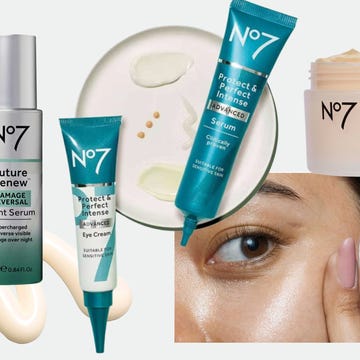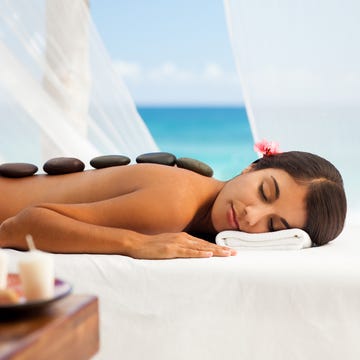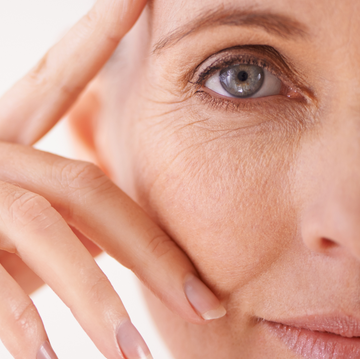Menopause has become one of beauty’s hottest buzzwords, with targeted ranges launching faster than you can say ‘hot flush’. But what does your face actually need at this time in your life? And does it mean binning everything you own and starting afresh?
Thankfully, the answer is no. While there are many excellent products formulated with the menopause in mind, the trick is knowing what to introduce, what ‘regular’ skin products to continue using and what might no longer be right for you.
What’s happening to my skin?
What to read next
As oestrogen levels decline, your body produces less collagen, the protein that keeps skin looking plump and youthful. ‘You can lose 30% of your collagen in the first five years post-menopause, which leads to reduced elasticity and firmness, sagging and loss of volume in the face,’ explains Dr Shahzadi Harper, menopause specialist and founder of The Harper Clinic.
Oestrogen is known as the ‘lubricating hormone’, she adds. ‘Declining levels mean the skin becomes increasingly dry, lined and lacklustre.’
Your skin gets thinner and may also feel tight, itchy or sensitive, adds Dr Naomi Potter, founder of the Menopause Care clinic. ‘You may experience a change in oil production, which can lead to clogged pores and breakouts,’ she says.
Uneven pigmentation is another common concern. Symptoms of the menopause vary and you’re unlikely to suffer them all, but however your skin is affected, it’s understandable you’d want to do something to make it look and feel its best.
What does my skin need?
You can find yourself tackling different issues at the same time – and it’s a balancing act. ‘You need powerful collagen boosters at a time when skin becomes more sensitised and prone to redness, and deep hydration while reducing the risk of triggering breakouts and hot flushes,’ explains dermatologist Dr Alia Ahmed.
To complicate matters, some of our trusted anti-ageing ingredients can aggravate hormonal skin. Dr Ahmed advises patients to tread gently when trying to boost collagen: use a lower-strength retinoid, for example, or a gentler alternative, such as peptides. ‘Stronger exfoliants, such as glycolic acid, can be replaced with gentler polyhydroxy acid (PHA), and thick moisturisers that might congest oily skin can be switched for cooling gels.’
Do I need specific menopause skincare?
The best menopausal skincare can pull these needs together in one focused package. The Good Housekeeping Institute reported impressive results after testing leading menopause skincare brands with the help of more than 500 perimenopausal, menopausal and postmenopausal women. Read the full results here.
One standout range was PRAI MenoGlow, which features collagen-boosting peptides, skin-healing lipids and the soothing Asian herb centella asiatica. Another strong performer was the No7 Menopause Skincare range, which was created with input from 7,000 menopausal women to effectively tackle the visual impact of oestrogen and collagen depletion. GHI’s testers also rated Living M, a whole brand built around the needs of this life stage, and Vichy’s Neovadiol range, made to both comfort and rejuvenate skin during and after the menopause, using active ingredients such as firming proxylane and anti-inflammatory cassia seed extract.
However, just because a skincare product doesn’t have ‘menopause’ on the label, doesn’t automatically mean it’s not right or optimal for this life stage, says Dr Catherine Borysiewicz, consultant dermatologist at GetHarley. ‘The key is to look for products with clinically proven ingredients, assess how your skin responds, and adjust your regime if necessary. The menopause affects all women differently, and there’s no one size fits all for skincare,’ she says.
Can HRT help my skin?
It’s not the primary reason you’d take it but yes, HRT can soften the visual effects of the menopause. ‘HRT can slow down collagen loss, improve skin hydration and enhance elasticity,’ says Dr Harper. ‘Many women report improvements in skin texture and appearance. We know from studies that women on HRT can look up to 10 years younger than those who aren’t.’
She adds: ‘HRT is great for skin from the inside out. I’d say the optimal approach is HRT to help skin from within, and then to use great skincare on top.’
Dr Potter adds: ‘Studies show HRT can decrease both the number and depth of wrinkles. Starting earlier may offer greater benefits for preventing collagen loss and maintaining skin thickness.’
The NHS offers regulated bioidentical hormones as well as synthetic, she notes. ‘Both types of HRT can support skin health, but bioidentical hormones may have an advantage as they more closely resemble the body’s natural hormones. It’s important to discuss any HRT option with your doctor, as everyone responds differently.’
How to build a menopause-friendly regime
Now the really important bit – which products and ingredients should you be focusing on when you’re updating your daily skincare regime? Here are the expert rules and tips to follow.
1.Respect your barrier
Your skin’s protective barrier weakens in menopause, leading to sensitivity and water loss. Protect it with a gentle approach. ‘A cream or oil-based cleanser can be less stripping,’ says Dr Ellie Rashid, CeraVe’s consultant dermatologist. ‘Moisturisers should be rich in ceramides, hyaluronic acid and fatty acids to help strengthen skin and prevent water loss.’
Dermatologist Dr Emma Wedgeworth also points to niacinamide as a great barrier booster, and recommends light, non-clogging oils such as squalane, hemp and jojoba. Exfoliate with gentle acids such as PHA, and no more than twice a week.
2. Take it slowly
Retinoids (forms of vitamin A, such as retinol) and vitamin C are gold-standard collagen boosters, whether you’re menopausal or not. If you’ve used them for a while, your skin will probably have some tolerance to their potentially irritating side-effects, but hormonal changes can sensitise you to anything. So how should you navigate this?
Introduce (or reintroduce) them slowly, one at a time, advises Dr Wedgeworth. Try a low-strength retinol (0.1% or less) or another form of retinoid, such as retinaldehyde, both of which are minimally aggravating. You can also buffer them with moisturiser and/or apply less frequently. For your vitamin C fix, ethyl ascorbic acid and tetrahexyldecyl ascorbate are vitamin C molecules shown to minimise irritation.
3. Consider phytoestrogens
Phytoestrogens are plant-derived antioxidant compounds that mimic oestrogen’s collagen-protecting benefits in skin, says aesthetics expert Dr Priya Verma. ‘By including them in a routine, menopausal skin can better retain moisture, firmness and resilience,’ she explains. ‘Key ones include genistein (from soy), which supports collagen production and improves elasticity; red clover extract, which helps to maintain skin thickness and hydration; and resveratrol, which enhances skin repair and reduces inflammation.’ Also look out for bakuchiol, which offers retinol-like rejuvenation minus the potential irritation. ‘It improves cell turnover and boosts collagen production,’ explains Dr Borysiewicz.
4. Try a retinoid alternative
These ingredients can help to reboot the collagen in your skin with less risk of aggravation.
PEPTIDES signal the skin to produce more collagen and elastin, helping to keep it firm and plump. Matrixyl 3000, tetrapeptide-21 and copper peptides are highly recommended by professionals. Growth factors are also ones to note, says Dr Verma. ‘These are biomimetic peptides – ones that mimic human biology to encourage cell regeneration.’
ANTIOXIDANTS are wider than just vitamin C. As well as phytoestrogens, look for astaxanthin, green or white tea, green coffee, vitamin E, co-enzyme Q10 and liquorice root, to name a few.
NIACINAMIDE supports collagen production and has anti-inflammatory benefits, says Dr Rashid. ‘This makes it particularly useful for those also experiencing redness or breakouts.’
5. Don’t nuke breakouts
Oily breakouts, blemishes and spots can become more common during menopause but need to be dealt with gently, as skin tends to be drier and more sensitive, says Dr Rashid. ‘The key is to use ingredients that help to clear breakouts without stripping the skin,’ she explains. ‘A gentle salicylic acid cleanser can help reduce congestion without causing excessive dryness. Azelaic acid is another effective option, as it reduces inflammation, prevents clogged pores and helps to fade post-acne pigmentation.’
Avoid more aggressive options such as high-strength benzoyl peroxide. If acne is a new problem, look at your regime and ‘ensure all the products you use are oil-free and non-comedogenic,’ advises Dr Borysiewicz. ‘There are great products to help mild acne, but if you’re not seeing any improvement, seek medical help from your GP or a dermatologist before scarring occurs.’
6. Soothe sensitivity
If your skin feels exceptionally dry or sensitive, ‘first, switch to a cream or oil-based cleanser, then dab your skin lightly afterwards with a muslin face cloth,’ advises Dr Verma. ‘Don’t make it completely dry and avoid using a body towel on your face. Then, layer your hydration, starting with a hyaluronic acid serum, followed by ceramide-rich moisturiser. Compromised skin may require barrier repair creams that contain shea butter, squalane and cholesterol to lock in hydration.’ Dr Rashid adds that oat-based or centella asiatica products can also be excellent for calming sensitivity and reducing itchiness.
7. Make SPF a priority
UV rays break down collagen all year round, so protect your skin by using a high-factor SPF every day, applying it to all exposed skin, including your face, neck, ears and even scalp if you have thinning hair. If you’re prone to pigmentation, ‘choose a product with broad-spectrum coverage against all three components of UV light: UVA, UVB and HEVL (aka blue light),’ says Dr Borysiewic.
This feature comes from Good Housekeeping’s new Menopause Handbook, a standalone magazine on the newstand now. For your ultimate guide to wellness in the menopause, BECOME A GH MEMBER and read the rest of the issue in the GH app.
































